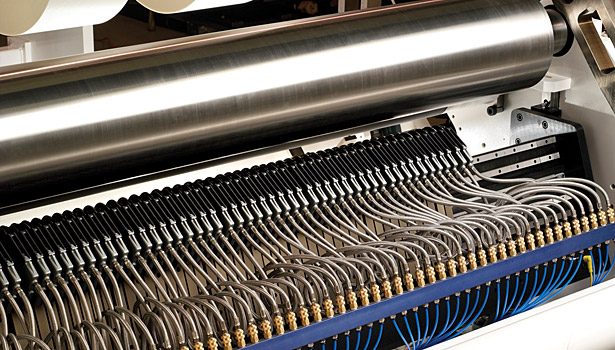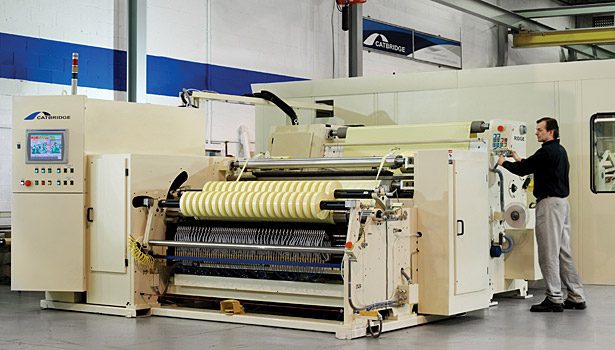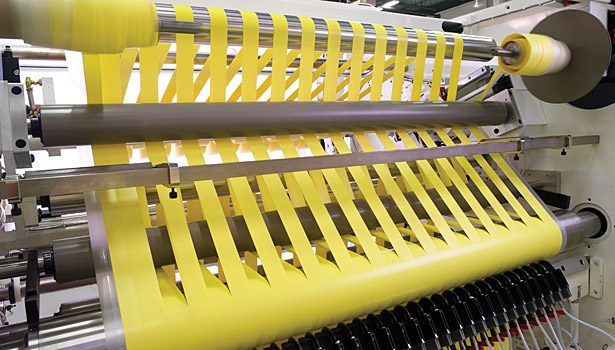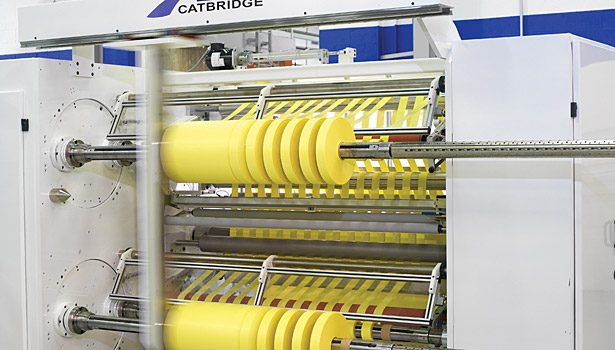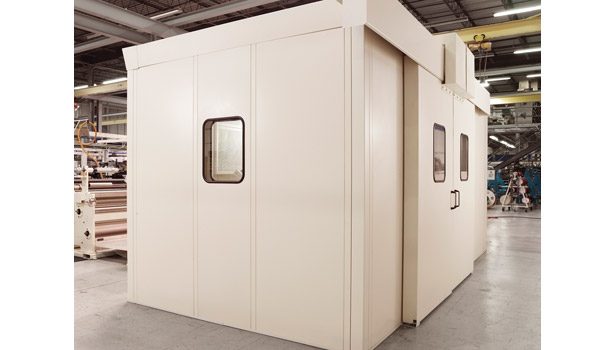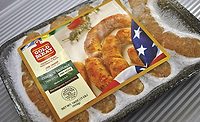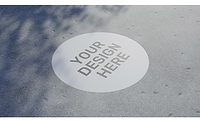Converting webs of pressure-sensitive adhesives (PSAs) presents a variety of challenges. The inherent sticky properties of adhesives can be problematic throughout the slitting and rewinding process. Starting at the unwind, adhesives create noise and tension spikes when coming off idler and pull rolls at the master roll. As they move through the web flow, adhesives can stick to equipment, build up on slitting blades and ooze during rewinding if not handled carefully. In addition, converting adhesives often requires adding or removing liners, collecting unlined trim, and adapting machinery to specific customer needs.
| Jump to: |
In order to effectively work with PSAs and produce high-quality finished rolls, specialized equipment is essential. Converting machinery can integrate features such as sound enclosures, non-stick roll coverings, traversing trim winders, blade wicking, tension isolation zones and precise control systems. The web flow can also be designed to minimize contact with exposed adhesives and properly position functions such as liner winding. Choosing the right solution depends on the nature of the web, the type of adhesive, the aggressiveness of the adhesive and the specifications of the finished product.
Unwinding PSAs
The special nature of pressure-sensitive slitting is evident at the unwind. Master rolls of adhesives are often misshapen or have special shaft requirements. In addition, sharp tension variations and high-decibel noise levels can occur when unwinding. As a result, unwinds for PSAs require features such as sound enclosures, peel-off rolls, infeed drive sections, wrinkle removal rolls and special chucks.
Sound enclosures are often necessary when unwinding film packaging tapes. Think of the tearing sound made by a consumer roll of film tape when used to wrap a package. That sound is multiplied when unwinding a 50- to 60-in. web of film tape at high speed. The decibels generated require the entire unwind to be located in a soundproof enclosure. These enclosures have special design features, such as slotted sliding doors to allow the loading of master rolls and removal of finished cores. They also require a small exit slot for the web to leave the enclosure.
Master rolls of PSAs are frequently out-of-round or egg shaped. The degree to which this occurs is a function of several factors, including the viscosity of the adhesive used, the web thickness, the temperature, core diameter and buildup ratio, and how long the roll may have been in inventory. Mitigating this problem is the focus of a number of steps and strategies from the moment the base material is coated with an adhesive.
Unwind features such as peel-off rolls, infeed drive sections and wrinkle removal rolls can help prepare the web for slitting. Peel-off rolls help even out the release of the adhesive across a web. Infeed drive sections maintain consistent tension output footage to the slitting zone, and wrinkle removal rolls smooth out any remaining tension-generated wrinkles prior to reaching the slitting or rewinding sections of the machine.
Pressure-sensitive unwinds may also need special chucks. Master rolls of PSAs are often wound on large diameter shafts, or “cans,” with ends requiring special chucks or adaptors. Large manufacturers frequently standardize their shafts from the coating through converting departments; winders on the coaters and unwinds on slitters must accommodate the same shaft ends. Master rolls may also be transported and stored on special racks. When this is the case, slitter unwinds must be made to lift out of these racks. This can involve a design specific to the customer’s racking system.
Removing Liners
Many pressure-sensitive materials are wound with a liner that must be removed prior to slitting and rewinding. Liner removal can be done at the unwind. In this case, simple driven winders, located behind the unwind, wind up the liner as the material is pulled off the master roll.
More commonly, liner winders are found in the web path between unwind and rewind. Locating the best position for these winders is an important step. They must be accessible for unloading and at a good point for peel-off from the adhesive web. Additional idlers are often necessary to obtain the correct web path to and from these units. After the release liners are removed and wound into rolls, they may be reused in the coating process.
Laminating
Some materials require that a liner be placed on the web after unwinding. It is not uncommon for a pressure-sensitive slitter to have both a liner unwind and liner winder. A material may require one type of liner during the coating process and another type of liner when being wound as a finished product.
Proper positioning of these liner unwinds is again key. Special web path design is necessary to ensure the liner is introduced in the correct position and at the correct point in the web conveyance. The liner unwind must also be located for easy and safe access for loading and unloading.
Processing Adhesive Webs
Processing unlinered or open-faced webs requires particular attention to the types and coverings of rolls coming into contact with the exposed adhesive. Web path design for exposed adhesives begins with a goal of minimizing the number of rolls contacted by the adhesive. Where adhesives must contact rolls, a number of solutions can be used to keep the adhesive from sticking to or transferring to the rolls. These include special non-stick roll surface coatings; some plasma coatings and tapes are effective. A contacted roll will occasionally be dimpled or grooved to lessen surface contact with the adhesive. The best solution for a particular product or family of products is a matter to be researched carefully. The right combination of web path and roll surfaces is critical to achieve the proper alignment and tension during web conveyance in order to avoid damage to the product.
Processing unlinered or open-faced webs requires particular attention to the types and coverings of rolls coming into contact with the exposed adhesive. |
Another unique characteristic of converting adhesive webs (exposed or linered) is the conveyance of web trim. Non-adhesive edge trim is commonly vacuumed away with a vacuum trim removal system. Such systems are problematic with adhesives, as the strands can stick to the inside of trim tubes. Over the years, attempted solutions have included coating trim tubes with nonstick materials or soap solutions. These methods are never foolproof and can be expensive and messy.
Trim winders are a popular solution. These are individual winders, often traversing types, packaged into the machine as closely as possible to the point where the trim is slit. They only need be changed occasionally, depending on the width of the trim taken, and are easily loaded and unloaded by hand. Again, good machine design is necessary to accommodate these winders at the optimal point in the web flow.
Slitting Considerations
The slitting section of a pressure-sensitive slitter rewinder also requires special attention. First, the correct type of slitting method must be selected. Choosing between shear (scissor), score (crush) or razor slitting is usually a function of two factors: the base web material and the minimum slit width.
Score is the most common slitting method for PSAs. The advantages are many: score knife holders are less expensive than shear tooling and are easily adjusted for various slit widths. They can be grouped close together (usually about half an inch apart) for narrow slitting. Today, most are pneumatically loaded, and pressures are easily adjusted for different materials. Score systems can also be equipped with intelligent manifolds that allow individual knives to be turned on and off in a programmable logic controller as part of a job recipe. This allows an operator to change slit patterns quickly while maintaining accuracy.
Another advantage to the score method is its effect on the web edge. For many materials, the scoring of the web between the blade and the anvil roll can serve to seal the edge, inhibiting the flow of viscous adhesives out from the edge. Shear and razor slitting also have their place in the pressure-sensitive world. Razor is used for many film tapes, and shear is common in labelstock work.
Adhesive buildup on knives—whether score, shear or razor—can be a problem and is most easily managed by score slitting. A common solution is the wicking of the blade. In this practice, a piece of felt is positioned against the blade. The felt is supplied with a mineral spirit or other material to lubricate the blade and prevent adhesive buildup. Without wicking, adhesives can build up and form small balls that can eventually drop off onto the web and cause quality problems in the finished rolls.
Winding Methods
Certain challenges can occur on wind-up as well. Of the three basic winding methods—surface winding, center-surface winding or pure center winding—the latter two are dominant in pressure-sensitive converting. They provide the ability to wind in minimum gap, fixed gap or lay-on control modes.
When winding, web tension built into the roll is critical. Too little tension on linered products can create loose rolls that can easily telescope. Too much tension on either linered or open faced (self-wound) products can squeeze the adhesive, causing it to ooze out at the roll edges.
Pressure-sensitive finished rolls are wound most frequently on duplex winders, since separating the rolls on alternating winding shafts is the only 100% foolproof method of preventing some materials from sticking together during the winding or discharge process. Duplex winding, however, has a basic disadvantage over common shaft winding. With a single-shaft winder, it is simpler and less time consuming to load and position cores, web the machine, and unload finished rolls. While duplex winding will remain the dominant choice for most pressure-sensitive work, it should be noted that more work today is possible on common shaft winders. This is primarily due to advances in web tension control, shaft technology and web spreading techniques.
Whether certain work can be wound on one shaft or two depends on factors such as minimum slit width, web thickness, finished roll diameter and the aggressiveness of the adhesive. When single-shaft winding is possible, the results are reduced downtime between sets and operator simplicity.
Conclusion
Despite the intrinsic complexity of handling PSAs, these materials can be converted successfully. From the unwind through the rewind, converting machinery must integrate features to address challenges like noise, tension and adhesive transfer. The web flow must be designed to create as short a web path as possible and to minimize the number of rolls contacted.
Optimal slitter rewinder performance and finished roll quality can be achieved with good web flow design, along with specialized features for handling adhesives. It is important to identify product families, finished roll parameters, and job size (number of sets/bars) in order to identify the best possible machine configuration and style.
For additional information, visit www.catbridge.com.
